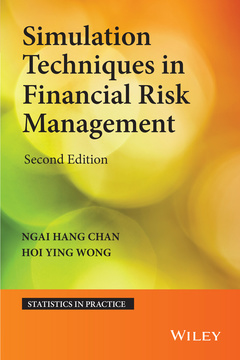Simulation Techniques in Financial Risk Management (2nd Ed.) Statistics in Practice Series
Auteurs : Chan Ngai Hang, Wong Hoi Ying

Simulation Techniques in Financial Risk Management, Second Edition takes a unique approach to the field of simulations by focusing on techniques needed by practitioners in the financial and risk management industries. Key concepts are illustrated with extensive use of examples and case studies in finance and risk management, readers can, then, reproduce the results of the studies using Excel® VBA (new to this edition).
In the new edition readers become well versed in many of the recent innovations in simulations and risk management, such as advanced option pricing models beyond the Black–Scholes paradigm, interest rate models, MCMC methods including stochastic volatility models simulations, model assets and model–free properties, jump diffusion, and state space modeling. A free author web site is also available.
List of Figures xi
List of Tables xiii
Preface xv
1 Preliminaries of VBA 1
1.1 Introduction 1
1.2 Basis Excel VBA 1
1.2.1 Developer Mode and Security Level 2
1.2.2 Visual Basic Editor 2
1.2.3 The Macro Recorder 5
1.2.4 Setting Up a Command Button 6
1.3 VBA Programming Fundamentals 8
1.3.1 Declaration of Variables 8
1.3.2 Types of Variables 8
1.3.3 Declaration of Multivariable 9
1.3.4 Declaration of Constants 9
1.3.5 Operators 9
1.3.6 User-Defined Data Types 10
1.3.7 Arrays and Matrices 11
1.3.8 Data Input and Output 12
1.3.9 Conditional Statements 12
1.3.10 Loops 13
1.3.11 Sub Procedures and Function Procedures 15
1.3.12 VBA’s Built-In Functions 18
2 Basic Properties of Futures and Options 19
2.1 Introduction 19
2.1.1 Arbitrage and Hedging 19
2.1.2 Forward Contracts 20
2.1.3 Futures Contracts 23
2.2 Options 26
2.3 Exercises 31
3 Introduction to Simulation 35
3.1 Questions 35
3.2 Simulation 35
3.3 Examples 36
3.3.1 Quadrature 36
3.3.2 Monte Carlo 37
3.4 Stochastic Simulations 38
3.5 Exercises 40
4 Brownian Motions and Itô’s Rule 41
4.1 Introduction 41
4.2 Wiener and Itô’s Processes 41
4.3 Stock Price 46
4.4 Itô’s Formula 47
4.5 Exercises 54
5 Black–Scholes Model and Option Pricing 57
5.1 Introduction 57
5.2 One Period Binomial Model 58
5.3 The Black–Scholes–Merton Equation 61
5.4 Black–Scholes Formula 67
5.5 Exercises 72
6 Generating Random Variables 75
6.1 Introduction 75
6.2 Random Numbers 75
6.3 Discrete Random Variables 76
6.4 Acceptance-Rejection Method 78
6.5 Continuous Random Variables 79
6.5.1 Inverse Transform 80
6.5.2 The Rejection Method 81
6.5.3 Multivariate Normal 83
6.6 Exercises 87
7 Standard Simulations in Risk Management 89
7.1 Introduction 89
7.2 Scenario Analysis 89
7.2.1 Value at Risk 91
7.2.2 Heavy-Tailed Distribution 92
7.2.3 Case Study: VaR of Dow Jones 94
7.3 Standard Monte Carlo 96
7.3.1 Mean, Variance, and Interval Estimation 97
7.3.2 Simulating Option Prices 99
7.3.3 Simulating Option Delta 102
7.4 Exercises 104
7.5 Appendix 105
8 Variance Reduction Techniques 107
8.1 Introduction 107
8.2 Antithetic Variables 107
8.3 Stratified Sampling 112
8.4 Control Variates 120
8.5 Importance Sampling 125
8.6 Exercises 131
9 Path Dependent Options 133
9.1 Introduction 133
9.2 Barrier Option 133
9.3 Lookback Option 135
9.4 Asian Option 136
9.5 American Option 138
9.5.1 Simulation: Least Squares Approach 138
9.5.2 Analyzing the Least Squares Approach 141
9.5.3 American Style Path Dependent Options 144
9.6 Greek Letters 145
9.7 Exercises 148
10 Multiasset Options 151
10.1 Introduction 151
10.2 Simulating European Multiasset Options 152
10.3 Case Study: On Estimating Basket Options 153
10.4 Dimension Reduction 155
10.5 Exercises 158
11 Interest Rate Models 161
11.1 Introduction 161
11.2 Discount Factor and Bond Prices 161
11.3 Stochastic Interest Rate Models and Their Simulations 165
11.4 Hull–White Model 167
11.5 Fixed Income Derivatives Pricing 171
11.6 Exercises 174
12 Markov Chain Monte Carlo Methods 177
12.1 Introduction 177
12.2 Bayesian Inference 177
12.3 Simulating Posteriors 179
12.4 Markov Chain Monte Carlo 180
12.4.1 Gibbs Sampling 180
12.4.2 Case Study: The Effect of Jumps on Dow Jones 183
12.5 Metropolis–Hastings Algorithm 188
12.6 Exercises 196
References 199
Index 203
Hoi-Ying Wong, PhD, is Professor in the Risk Management Science Program of the Department of Statistics at The Chinese University of Hong Kong. Professor Wong is also associate editor of one journal and the author of Handbook of Financial Risk Management: Simulations and Case Studies, also published by Wiley. His research interests include derivatives pricing, interest rate modeling, financial risk management, and statistical finance.
Date de parution : 05-2015
Ouvrage de 232 p.
16.1x24.1 cm
Disponible chez l'éditeur (délai d'approvisionnement : 12 jours).
Prix indicatif 121,14 €
Ajouter au panier


